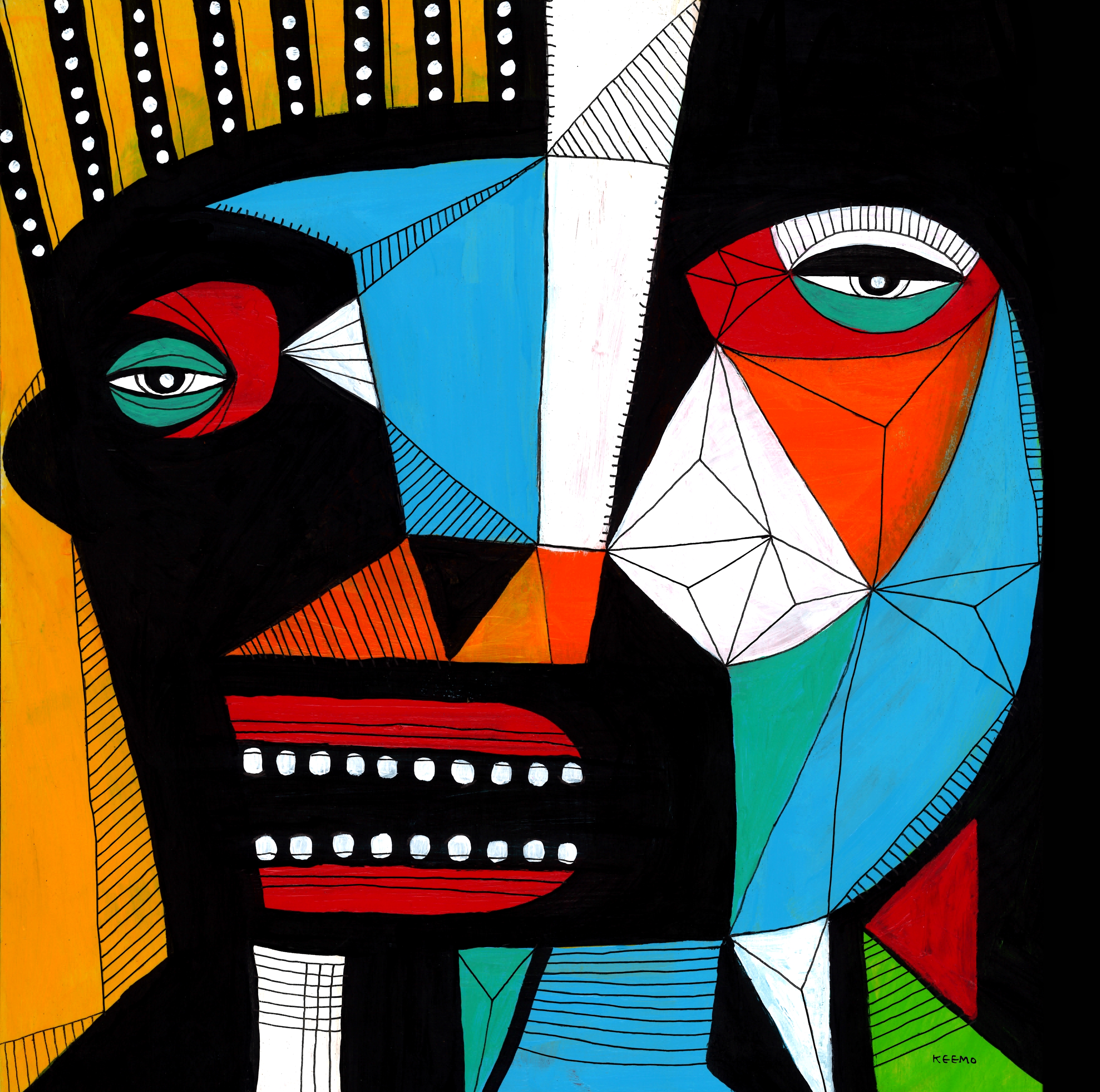A friend on social media recently indicated that dating in Grand Rapids is an unhappy prospect because there’s a pretty good chance you’ll run into an ex. Indeed, everyone seems to know everyone, which is why I was surprised that I hadn’t met Keemo.
Soon after my first encounter with Keemo’s art I purchased one of his mixed-media works, a stylized portrait in his signature red, turquoise, lime and cadmium yellow — with an enigmatic morsel of text framed within the face.
Keemo’s art looks like Jean-Michel Basquiat’s paintings if he wasn’t using drugs — or Paul Klee’s if he was. There’s cleverness and vitality akin to Basquiat, with the whimsy and humor of Klee, reigned-in with the disciplined sensibility of a graphic artist. His love of text and letterforms hints at his past life as a graphic designer. The piece I purchased featured type from a bonafide typewriter.
Many of his collages involve painting on found images like vintage yearbook or magazine pages. And while he’s quick to impose upon the images, there’s some reluctance to muddle too much with the existing text and layout.
His most recent works resemble targets for a psychedelic-shooting range. This series consists of wood panels with vibrant cubist-inspired interjections upon the faces and torsos of silhouetted figures and animals.
I contacted Richard App to inquire if he thought the enigmatic Keemo would be receptive to an interview. Maybe the artist preferred to keep a low profile like Banksy, or perhaps he was a fugitive of the law, or a recluse like J.D. Salinger, or maybe he was Finnish or Samoan and Keemo was his real name. App soon responded that Mr. Keemo would be happy to oblige.
Keemo aka Curt Ankin is represented by App, but also sells work to an international coterie of collectors through keemogallery.com. Ankin indicated he has a good relationship with App, who didn’t require an exclusive commitment to the gallery. This kind of “open relationship” is exceptional since a gallery often wants to retain control of the sales of their artists’ work. As for rookie artists looking to get recognition, Ankin said it’s all about elbow grease. “Try to create something every day, even something simple,” he said. “Just to keep it flowing … or clean-up, organize — do whatever, every day. Paintings don’t make themselves. Relationships don’t build themselves.”
Ankin and I sat in the shade while he discussed the trajectory of his career, the evolution of his work and the origins of his nom de plume — which he assures me is more amusing when embellished with a few drinks. He also stated how “art is the only thing with rules that are self-imposed” — noting the liberty artists have to write their own history and carve their own artistic paths.
But as for his artist moniker, that bit of early-days Keemo history was prompted by a “grooming malfunction” (aka bad haircut) which unfortunately transpired on the eve of an important presentation. With no way to conceal the damage to his hairdo, he decided to shave his head — bald. The next morning his clean-shaven dome prompted relentless mockery by the client. Yes, apparently some people think chemotherapy is hilarious. Years later Ankin decided to reclaim the epithet as an ironic way of confirming his resolve to be a full-time artist.
Keemo’s name is just one example of his ability to transform adversity.
Most artists encounter challenges, but not all of them have the tenacity to push through. In the early 1990s there were few options to sell work outside of galleries or crafts shows. Ankin duly schlepped his portfolio to prospective galleries without success, but his aesthetic sensibility served him well as a professional graphic artist and website designer. Web design was the segue to fully supporting himself as a fine artist. His slick website is regularly updated with new works and posts. He tends to his social media and diligently maintains an e-mail list to keep collectors informed. In short, his work is not limited to the production of paintings.
When I asked if there was anything he’d do differently he said, “I wish I hadn’t lived with so much self-doubt and insecurity when I was younger — like taking rejection of my work to be an indication of my worth as an artist or a person.”





